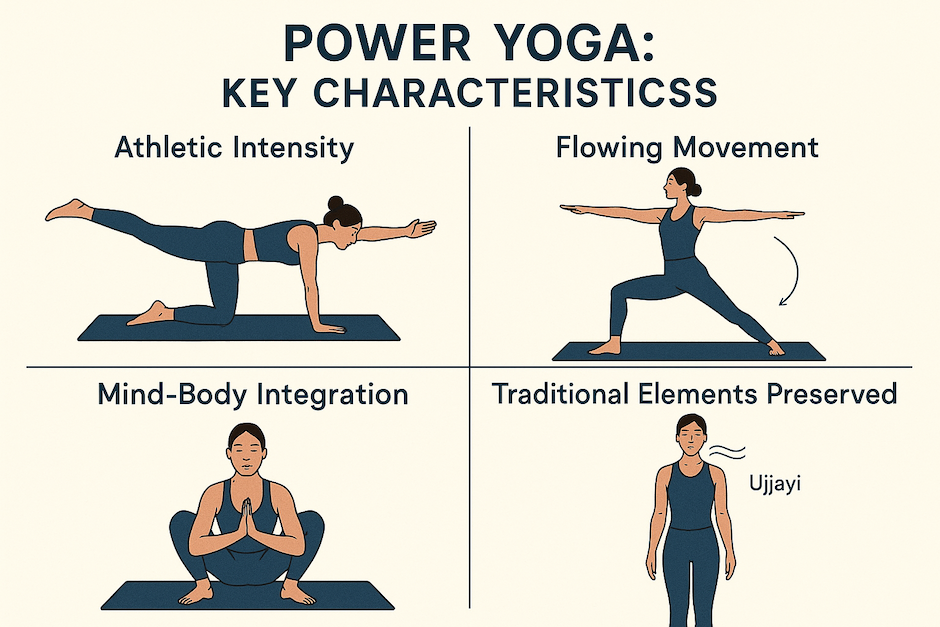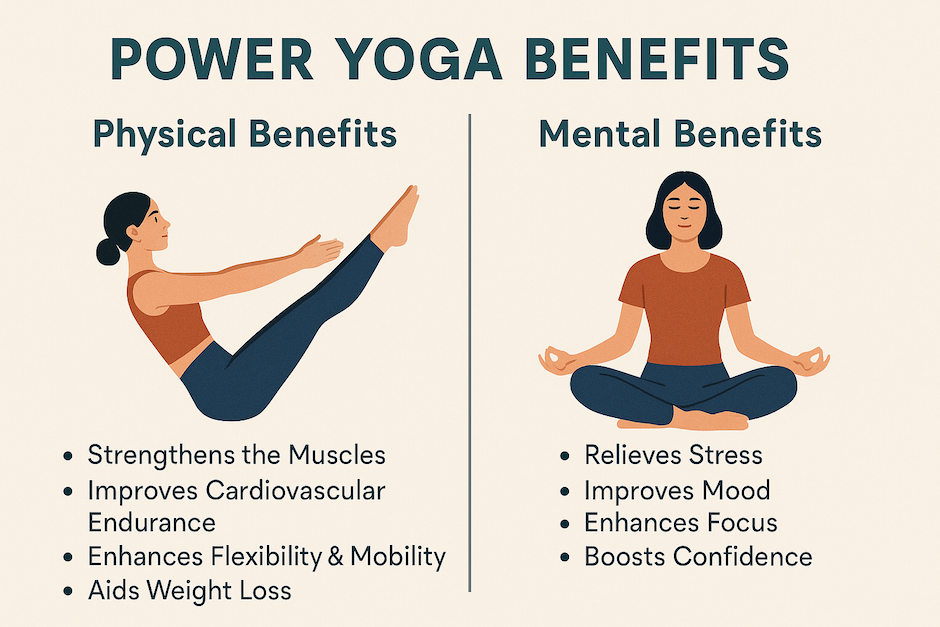
%20(1).webp)
Looking for a workout that builds strength, burns calories, and improves flexibility while keeping your mind calm and focused? That’s exactly what Power Yoga delivers.
So, what is Power Yoga? At its core, it’s a vigorous, fast-paced style of yoga that transforms traditional poses into a high-intensity, strength-building practice. It is an intense practice that focuses on building muscle and improving cardiovascular endurance. The transitions are fast, creating a dynamic sequence including standing and seated poses along with inversions.
Power Yoga offers a full-body workout that still honors the breath, mindfulness, and philosophical roots of yoga while keeping your heart rate elevated. You’ll sweat and push yourself harder, finishing feeling stronger, more energized, and centered.
In this guide, you’ll discover:
To experience Power Yoga in its most authentic form, book a free 1-on-1 session today!
Power Yoga is a vigorous, athletic style of yoga that combines the mind-body awareness of traditional yoga with the strength, endurance, and calorie-burning benefits of modern fitness training. Developed in the 1990s, it offers a dynamic, flowing practice that challenges your muscles, builds stamina, and keeps you mentally engaged from start to finish.
Unlike classical yoga systems such as Ashtanga, which follow a fixed series of postures, Power Yoga allows creative freedom to practice sequences that suit your energy and goals. This means that while all Power Yoga sessions aren’t exactly alike, all of them do emphasize continuous movement, strength-building postures, and mindful breathing.
In a typical Power Yoga session, you’ll move through a fast-paced flow that includes standing poses, balance challenges, core work, arm balances, and deep stretches. All movements are linked with Ujjayi breathing, which helps you stay focused and generate heat from within.
For many practitioners, Power Yoga offers the best of both worlds:
This unique balance makes it a go-to practice for anyone seeking total-body fitness without losing the mindful, grounding benefits of yoga.
Learn more about Power Yoga Poses here!
While Power Yoga may feel like a modern fitness trend, its roots run deep in traditional yoga practice. To understand its evolution, let’s take a deeper look at its origins.
The foundation of Power Yoga lies in Ashtanga Yoga, a rigorous, structured system developed and popularized by Sri K. Pattabhi Jois in Mysore, India. Ashtanga follows a set sequence of postures, linked together by breath and movement in a flowing rhythm known as Vinyasa.
In the early 1990s, American yoga teachers such as Beryl Bender Birch, Bryan Kest, and Baron Baptiste began adapting Ashtanga for Western audiences with the aim to make yoga more accessible to people seeking intense, athletic workouts while still offering the mental and spiritual benefits of traditional practice.
This included:
This blending of tradition and innovation became known as Power Yoga — a practice that honors yoga’s roots while embracing the challenge and versatility modern practitioners crave.
Power Yoga quickly spread beyond yoga studios and into gyms, fitness centers, and athletic training programs. It appealed to:
Today, Power Yoga is recognized worldwide as a bridge between traditional yoga and modern fitness training. It remains a dynamic, evolving practice that fills the gap between ancient wisdom and contemporary athletic goals — the perfect match for practitioners seeking both physical transformation and mental clarity.
To experience this blend of tradition and modernity, book your free 1-on-1 Power Yoga Session today!

While Power Yoga offers creative flows and variety, the sessions share a few defining traits that set them apart from other forms of yoga.
At its heart, Power Yoga is physically demanding.
This makes Power Yoga especially appealing to fitness enthusiasts, athletes, and active individuals looking for a workout that challenges the whole body.
Unlike Ashtanga, Power Yoga doesn’t follow a fixed sequence.
This flexibility allows practitioners to experience the discipline of yoga without feeling restricted by repetition.
Even with its athletic pace, Power Yoga maintains yoga’s mental and spiritual dimensions.
This makes Power Yoga not just a workout, but a moving meditation that strengthens both body and mind.
Despite its modern athletic appeal, Power Yoga honors its heritage.
By preserving these traditions, Power Yoga offers the best of both worlds — the rigour of athletic training grounded in the wisdom of ancient yoga.

Power Yoga offers a total-body, mind-focused workout that builds strength, improves endurance, and sharpens mental clarity. Whether your goal is weight loss, greater flexibility, or stress relief, its benefits are both physical and mental.
Power Yoga blends intense physical training with mindful practice, making it just as valuable for mental clarity as it is for physical transformation.
Want to experience the benefits of Power Yoga? Try this group class on Functional Power Yoga today!
While all forms of Power Yoga share the same strength-building, flow-based foundation, there are several variations you might encounter. These include:
Power Flow Yoga (sometimes called Vinyasa Power Flow) emphasizes continuous, flowing movement while maintaining the athletic intensity Power Yoga is known for.
It’s best for those who want a challenging workout but enjoy the fluidity and artistry of yoga. It’s especially appealing to dancers, athletes, and yogis who love flow-based practice but crave more intensity.
Key Characteristics:
Experience Power Flow Yoga in this group class!
Power Vinyasa Yoga blends traditional Vinyasa sequences with the strength and endurance demands of Power Yoga. This style is ideal for practitioners who enjoy the rhythm and breathwork of Vinyasa Yoga but want more of a physical challenge.
Key Features:
Hot Power Yoga takes the intensity up a notch by holding classes in a heated room — typically between 85°F and 95°F (29°C–35°C). It is an excellent option for seasoned practitioners who enjoy high intensity and want to combine strength, flexibility, and detox in one session.
Benefits:
Considerations:
Learn more about Hot Yoga in this detailed guide!
Understanding how Power Yoga compares to other popular styles can help you decide if it’s the right fit for your goals.
Power Yoga is best for you if you:
If you’re looking for a yoga practice that doubles as a full-body workout while still preserving the mindful essence of yoga, Power Yoga may be your ideal match.
Still confused among the various yoga styles? Book a free 1-on-1 session and let our expert coaches guide you!
From athletes to busy professionals, Power Yoga is suitable for anyone ready for a challenging, fast-paced workout. It’s especially great if you want to:
Tips for Your First Class:
Because Power Yoga is physically demanding, the right instructor makes all the difference. A qualified teacher will:
At MyYogaTeacher, our coaches combine traditional yoga wisdom with modern fitness expertise. Every session is tailored to your needs, ensuring you get results safely and effectively.
Whether you’re looking to enhance sports performance, lose weight, or deepen your yoga practice, Power Yoga offers a transformative path to better health and well-being.
Experience Power Yoga in its most authentic form — book your free 1-on-1 session today.
Power Yoga is a vigorous, athletic style that emphasizes strength, endurance, and continuous movement. It differs from gentler yoga styles by maintaining a faster pace and incorporating more strength-focused poses, while still preserving yoga’s breath-movement connection and mindfulness.
Power Yoga benefits include:
It’s a complete mind-body workout in one practice.
Yes. A single session can burn 400–600 calories while building lean muscle mass, which boosts metabolism. Combined with healthy nutrition, Power Yoga can support sustainable fat loss and improved body composition.
Not necessarily. While some fitness experience can help, beginners can start Power Yoga by using modifications and progressing gradually under the guidance of a coach.
For most people, 2–4 sessions per week is ideal. This allows for strength and endurance gains while giving your body time to recover between intense practices.
Power Flow Yoga focuses on continuous, flowing movement with athletic intensity, while Power Yoga may include more static holds and strength-focused poses. Both are vigorous, but Power Flow leans more toward fluid transitions.

Receive personalized guidance tailored to your unique fitness goals, live with a dedicated coach—no credit card required.